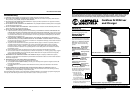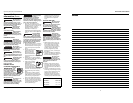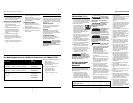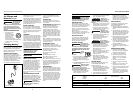
Operation (Cont’d.)
Do not use the
power of the drill
to loosen or tighten bit while holding
chuck. The spinning chuck will cause
friction burn or hand injury.
REMOVING CHUCK
Remove battery pack. Rotate clutch
ring to drill bit symbol and open chuck
all the way. Turn left-hand-threaded
screw inside chuck clockwise, and
remove it . Insert the short arm of a
3/8" hex key wrench and close jaws on
flats of wrench.
Strike long arm of wrench sharply
counterclockwise, remove wrench and
unthread chuck from spindle.
INSTALLING CHUCK
To install chuck, reverse “Removing
Chuck” procedure. Always keep the
spindle threads, chuck threads, and
securing screw free of debris.
GENERAL DRILLING
The front end of
the Drill/Driver may
be made “live” if the tool drills into
live wiring in the wall. TO PREVENT
ACCIDENTAL ELECTRICAL SHOCK, HOLD
DRILL/DRIVER ONLY BY THE SOFT GRIP
HANDLE.
Safety
glasses
must be worn during
operation.
1. Set torque adjusting collar for
drilling operation and set speed
selector to appropriate speed.
2. Be sure drill bit is securely gripped
in chuck.
3. Set FORWARD/REVERSE BUTTON for
clockwise rotation.
Make sure work is
held securely in a
vice or clamped in place prior to
starting drilling operation. Loose work
may spin and cause bodily injury.
4. Locate exact center for hole to be
drilled and using a center punch,
make a small dent in work.
!
CAUTION
!
WARNING
!
WARNING
!
CAUTION
5. Place tip of drill bit in dent made by
center punch, hold drill square with
work, and start the motor.
Applying too
much pressure may
cause the bit to overheat or break,
resulting in bodily injury or damaged
drill bits.
Apply steady, even pressure to keep
drill bit cutting. Too little pressure
will keep the bit from cutting.
Eventually, the excessive friction
created by sliding over the surface
will dull the cutting edges.
Always be alert
and brace yourself
against the twisting action of the drill.
6. If drill stalls or becomes jammed in
the hole, release trigger
immediately, remove drill bit from
work and determine cause of
stalling or jamming.
Do not squeeze
trigger on and off in
an attempt to free a stalled or jammed
drill. This will damage the motor.
The direction of rotation may be
reversed to help free a jammed bit.
Be sure direction of rotation is
RESET before attempting to
continue drilling.
7. Reduce the pressure on the drill just
before the bit cuts through the
work to avoid splintering wood or
stalling in metal.
8. When bit has completely
penetrated work and is spinning
freely, withdraw it from the work
while the motor is still running,
then turn off drill.
DRILLING WOOD
In addition to the instructions listed
under GENERAL DRlLLlNG, the
following also apply:
1. When using a twist drill in wood,
frequently withdraw it from the hole
to clear away chips which build up in
the flutes. This helps prevent
overheating and burning work.
2. If a backing block is used to keep
back of work from splintering,
NOTICE
!
CAUTION
!
CAUTION
clamp it securely in place. If a
backing block is not used with
spade bits or hole saws, ease up
pressure as soon as bit point breaks
through work, and complete the
hole from the opposite side.
DRILLING METAL
In addition to the instructions listed
under GENERAL DRlLLlNG, the
following also apply:
1. Use only good quality sharp high
speed steel twist bits when drilling
metal.
2. Start drilling with slow speed and
gradually increase speed as drill cuts.
The harder the material, the slower
the speed required. The softer the
material, the faster the speed.
3. When drilling a large hole, it is easier
to first drill a smaller hole and then
enlarge it to the required size.
4. The use of a lubricant, such as oil,
on the drill point helps keep the bit
cool, increases drilling action and
prolongs drill bit life.
5. If possible, punch the drilling
position first to prevent drill bit run
away.
DRIVING WOOD SCREWS
1. Drill pilot and shank clearance
holes. See chart titled “Suggested
Hole Sizes for Wood Screws.”
2. Install proper screwdriver bit.
3. Set torque adjusting collar for
desired torque and set speed
selector to “1,” the low-speed
setting.
4. Set drill for correct rotation.
5. Start screw straight in hole with
fingers.
6. Place bit on screw, start drill and
exert pressure to drive screw.
7. As soon as screw has seated, release
trigger, and lift screwdriver from
screw.
8. A lubricant, such as soap or wax,
may be used on screw threads for
ease of driving. This is particularly
important in hard wood.
5
Suggested Hole Sizes For Wood Screws
Shank Drill Pilot Drill Diameter
Screw Clearance Soft Hard
Size Diameter Wood Wood
#6 5/32 (.156) 1/16 (.062) 5/64 (.078)
#8 11/64 (.172) 5/64 (.078) 3/32 (.093)
#10 13/64 (.203) 3/32 (.093) 7/64 (.109)
#12 15/64 (.234) 7/64 (.109) 1/8 (.125)
DX111425CD & DX151905CD
www.chpower.com
Operating Instructions and Parts Manual
4
www.chpower.com
Safety Instructions
for Charger and
Batteries (Cont’d.)
BATTERY DISPOSAL
Do not attempt to
disassemble the
battery or remove any component
projecting from the battery terminals.
Fire or injury may result. Prior to
disposal, protect exposed terminals
with heavy insulating tape to prevent
shorting.
NICKEL-CADMIUM BATTERY
• If equipped with a
nickel-cadmium
battery, the battery
must be recycled or
disposed of in an
environmentally
sound manner. Check with your
county’s Public Works Department
for information on recycling
batteries.
Charging Battery
REMOVING BATTERY PACK
Before charging, remove battery pack
from Drill/Driver by depressing the
battery release button and pulling the
battery pack out of tool.
GENERAL INSTRUCTIONS
With normal use, as battery pack
approaches the discharged state, you
will notice a sharp drop in tool
performance. When the tool is unable
to perform the task at hand, it is time
to recharge the battery pack.
Recharging the battery pack before
this condition is reached will reduce
!
WARNING
the total work life of the pack.
Discharging the pack beyond this point
can damage the pack.
NOTE: Battery temperature will increase
during and shortly after use. Batteries
may not accept a full charge if they are
charged immediately after use. Do not
charge battery pack if it feels hot to the
touch. Wait for it to cool.
INITIAL CHARGING
Before using the cordless Drill/Driver
for the first time, charge the battery
fully. Depending on room temperature
and line voltage, the battery should be
fully charged in six (6) to ten (10)
hours.
CHARGING
Connect the current carrying prongs
on the power cord to a 230V / 240V AC
50Hz wall outlet. Connect the other
end of the power cord to the battery
pack. If the charger is equipped with
an LED, a red light will light up as long
as the battery pack is connected to the
charger and the charger is plugged in.
With normal use, the battery pack will
be fully charged after about three (3)
to six (6) hours. Disconnect charger
from power source when not in use.
IMPORTANT: THE BATTERY PACK
SHOULD NOT BE LEFT ON THE
CHARGER FOR MORE THAN
FORTY-EIGHT (48) HOURS.
Operation
VARIABLE-SPEED TRIGGER
SWITCH (some models)
If your Drill/Driver is equipped with
a variable-speed trigger switch, the
pressure you apply to the trigger
controls the tool speed. Apply more
pressure to increase the speed and
release pressure to decrease speed.
This accurate speed control allows you
to drill without center-punching and
to use the Drill/Driver as a power
screwdriver. Bits are available for
driving screws as well as running bolts
and nuts.
FORWARD/REVERSE BUTTON
This Drill/Driver is equipped with a
forward/reverse lever which is used to
change the rotation of the chuck. Do
not attempt to change the rotation
unless the chuck is completely stopped.
Moving the
Forward/Reverse
Button while chuck is rotating can
damage the tool.
NOTICE
For forward rotation, firmly press in on
the lever marked FWD. For reverse
rotation, firmly press in on the lever
marked REV.
TRIGGER LOCK
To activate trigger lock, move the
forward/reverse lever so it is centered
in the handle.
GEAR SHIFTING (DG151905CD only)
The DG151905CD Drill/Driver is
equipped with two separate gear
ranges, low and high. Low gear
provides high-torque and slower
drilling speeds for heavy duty work or
for driving screws. High gear provides
faster speeds for drilling lighter work.
To change speeds, slide switch to the
high or low position. Actuate trigger
slightly if the gear shift does not fully
engage.
Note: If Drill/Driver is running, but the
chuck will not turn, check to make sure
the gear shifting switch is pushed fully
into desired setting.
ADJUSTABLE CLUTCH
This Drill/Driver features 16 clutch
settings. Output torque will increase as
the clutch ring is rotated from 1 to 16.
1 to 2for driving small screws.
3 to 4for driving screws into soft
materials or plastics.
5 to 7for driving screws into
softwoods.
8 to 10for medium woods.
11 to 14for driving screws into
medium / hard woods.
15 to 16for driving screws into metal.
The “drill” position locks up the clutch
to permit heavy-duty drilling and
driving work. It also allows bits to be
changed quickly and easily in the
keyless chuck.
INSERTING BITS
Move Forward/Reverse Button to the
center “Off” position. Remove battery
pack (See “Charging Battery” section)
and rotate the clutch ring to the drill
bit symbol. Rotate the chuck sleeve
counterclockwise (viewing from chuck
end), and open chuck to approximate
drill bit diameter. Insert a clean bit up
to the drill bit flutes for small bits, or
as far as it will go for large bits. Close
chuck by rotating the chuck sleeve
clockwise and securely tighten by
hand.
Charger and Battery






